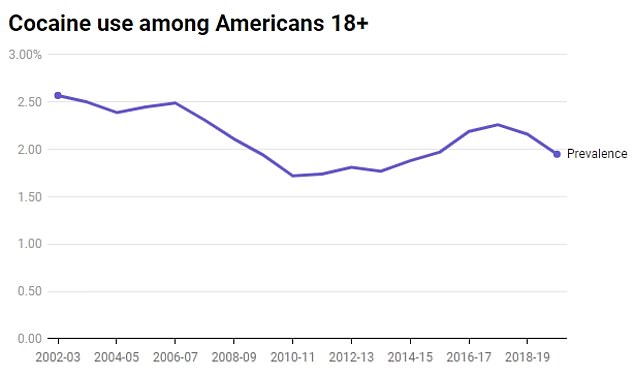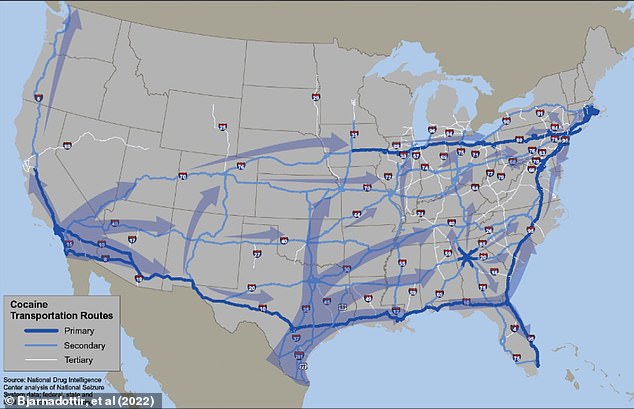The shock map reveals surprising conditions where the use of most cocaine users is highest
It’s the drug that’s powered Hollywood parties and Wall Street trading floors for decades.
But Colorado, not California or New York, is home to the most cocaine users in the United States, figures show.
Data from a Substance Abuse and Mental Health Services Administration (SAMHSA) study shows more than Three percent of residents aged 18 and over – approximately 96,000 people – reported using some form of cocaine in the past year.
Colorado was followed by Vermont, where three percent of adults used cocaine, 2.7 percent in Rhode Island and 2.6 percent in Massachusetts. California rounded out the top five with 2.5 percent.
Cocaine use is highest in Colorado and lowest in Arkansas
Overall, in 2022, approximately two percent of Americans aged 18 and older reported using cocaine in the past year, and nationwide cocaine use has been declining since the 2017-2018 survey year.
Cocaine, commonly known as “coke,” is illegal in all forms in the US and the penalties for possession of the drug vary depending on several factors, but can range from five years to life in prison and millions in fines.
The research does not explain why cocaine use is highest in these states, but this could be due to their more relaxed attitude towards illegal drugs.
Marijuana is legal for recreational use in all states and is in the top five for highest cocaine use.
Wyoming has the fewest cocaine users, with 1.3 percent reporting drug use in the past 12 months.
This was followed by New Hampshire (1.37 percent), Arkansas (1.38 percent), South Dakota (1.4 percent) and Texas and Alaska, both with 1.45 percent residents.
Nationally, use of the drug in any form is highest among Americans ages 18 to 25, with 3.7 percent in that age group reporting past-year cocaine use in 2022.
This is a clear decrease compared to the previous research year 2018-2019, when the prevalence was 5.5 percent.
No results have been reported for 2020-2021.
Cocaine use among this age group was highest in the 2005-2006 survey, when seven percent of people reported drug use.
Among all Americans aged 18 and older, cocaine use was highest (2.6 percent) in the 2002-2003 survey year.

Cocaine use in the US has been declining since the 2017-2018 SAMSHA survey year
Cocaine is a powerful stimulant and comes from the leaves of the coca plant. It is sold as a white powder and is snorted. It can also be dissolved in water and injected into a vein.
When cocaine is heated into a crystallized rock form, it is called crack cocaine and is inhaled. This produces the fastest and most intense high.
People who use the drug report feelings of euphoria, increased mental alertness and increased energy.
But they may also experience restlessness, irritability, anxiety, fear and paranoia.
People who use cocaine are at risk of cardiac complications, such as a heart attack, but also of seizures, coma, stroke and gastrointestinal complaints.
In the United States, cocaine is a Schedule II substance: the second highest drug classification. This indicates that it has a reduced addiction potential, but a high risk of dependence.
There is also a high risk of abuse.

Drugs in this category are typically prescribed to treat severe pain, anxiety, ADHD, and insomnia. They include fentanyl, methamphetamines, morphine, oxycodone and morphine.
Schedule II drugs have the strictest regulations compared to other prescription drugs.
A gram of cocaine, a common benchmark, costs anywhere from $60 to $200 in the US. Crack cocaine is typically the cheapest form of the drug, ranging from $80 to $100 per gram.
In the US, penalties for cocaine possession vary widely depending on the quantity, number of prior offenses, location, and other crimes related to drug trafficking or use. The sentence can range from five years to life imprisonment plus fines that can run into the millions.
Columbia is the world’s largest producer of cocaine and is often the origin of the drug entering America.
According to a 2022 studyThe major transportation routes for cocaine include along America’s southern border, the East Coast, and the southern half of the West Coast. From there, the drug is transported to the central states of the US and north into Canada.
